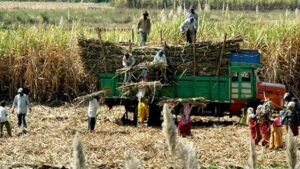
Why Sugarcane in news?
- Sugar, a universally loved ingredient, stirs up a global controversy in the case of India’s sugarcane subsidies.
- The World Trade Organization (WTO) is the battleground, with the US and Australia accusing India of exceeding permissible support limits and distorting international trade.
- Let’s delve deeper into this complex issue, exploring the WTO’s regulations, the specific allegations against India, and the potential consequences.
The WTO’s Agreement on Agriculture: A Balancing Act
- Established in 1995, the AoA aims to create a fair and market-oriented agricultural trading system. It has three key pillars:
- Domestic Support: This pillar focuses on reducing trade-distorting subsidies. WTO categorizes subsidies as:
- Blue Box: Deemed minimally trade-distorting, these subsidies support farmers’ income, environmental programs, and certain rural development initiatives.
- Green Box: These are generally considered non-trade distorting, like providing research assistance or infrastructure development in rural areas.
- Amber Box: These subsidies have the potential to distort trade and are subject to reduction commitments.
- Market Access: This pillar promotes market liberalization by reducing tariffs and non-tariff barriers (like quotas) on agricultural imports.
- Export Subsidy: This pillar discourages practices like providing financial assistance to make exports cheaper, potentially harming domestic industries in other countries.
The Allegations Against India: Exceeding Limits and Lack of Transparency
- The US and Australia claim India’s domestic support measures for sugarcane violate the AoA. Here’s a breakdown of the accusations:
- Excessive Market Price Support: India’s Fair and Remunerative Price (FRP) system, which sets a minimum price sugar mills must pay to farmers, allegedly exceeds the 10% limit allowed under the AoA. The US and Australia argue that for the period 2018-2022, India’s market price support consistently surpassed 90% of the value of sugarcane production.
- Opaque Reporting: India hasn’t included sugarcane or its derivatives in its domestic support notifications since 1995-96. This lack of transparency makes it difficult for the WTO to assess India’s compliance with AoA regulations.
India’s Defense: A Matter of Interpretation and Calculation
- India counters these allegations, arguing that the WTO panel misconstrued its support programs. Here are the key points of India’s defense:
- Misinterpretation of Price Support:
- India contends that the FRP system doesn’t constitute market price support as defined by the AoA.
- They argue that the calculations by the US and Australia consider all sugarcane production, regardless of whether it reaches sugar mills for processing. This, according to India, inflates the subsidy figures.
- Sugarcane Control Order Nuances:
- India highlights the role of the Sugarcane (Control) Order, 1966, which regulates various aspects of the sugarcane industry. India argues that FRP applies only to sugarcane delivered to mills for crushing, not the entire national production.
- Misinterpretation of Price Support:
The Impasse and the Path Forward
- The dispute resolution process at the WTO faces a roadblock.
- With the WTO’s Appellate Body currently dysfunctional due to member country disagreements, India’s appeal against the initial panel’s ruling remains unaddressed. This highlights the complexities of enforcing WTO regulations in a world with diverse agricultural policies and economic realities.
Potential Consequences: A Double-Edged Sword
- If the WTO upholds the initial ruling against India, potential consequences include:
- Trade Retaliation: The US and Australia could be authorized to impose tariffs or other trade barriers on Indian goods, impacting bilateral trade relations.
- Domestic Market Impact: Reduced subsidies could lead to a decline in sugarcane production, potentially affecting farmer livelihoods and sugar prices within India.
- However, addressing concerns about excessive subsidies could also lead to:
- A More Level Playing Field: Reducing subsidies could create a fairer global market for sugar, benefiting countries that rely on sugar exports.
- Long-Term Sustainability: Re-evaluating subsidy programs could encourage India to adopt more sustainable and market-oriented practices in the sugarcane sector.
Conclusion
- The India-US-Australia sugar subsidy dispute underscores the challenges of balancing national agricultural policies with WTO regulations. Open and transparent communication, coupled with a willingness to find common ground, are crucial for resolving this issue.
- Perhaps a solution lies in reforming India’s subsidy programs to ensure farmer well-being while adhering to WTO principles.
- This could pave the way for a more sustainable and equitable global sugar trade ecosystem.
People also ask
Q1 : What’s the controversy surrounding India’s sugarcane subsidies?
Ans : The US and Australia accuse India of providing excessive subsidies to sugarcane farmers, violating WTO (World Trade Organization) regulations. These subsidies, mainly through a guaranteed minimum price (FRP) system, allegedly distort global trade in sugar.
Q2 : What’s the ideal outcome for this dispute?
Ans: solution balancing India’s farmer support with WTO regulations is crucial. Open communication and a willingness to find common ground could lead to reforms in India’s subsidy programs. This could pave the way for a more sustainable and equitable global sugar trade ecosystem, benefiting producers and consumers worldwide.
Can you be more specific about the content of your article? After reading it, I still have some doubts. Hope you can help me.